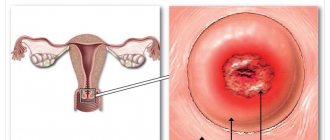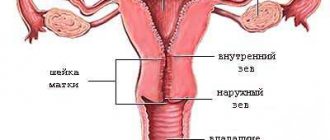The biopsy procedure is performed on the patient only after passing a certain list of tests, a referral for which is issued by a doctor. The list includes the following studies:
- HIV test;
- for hepatitis B and C;
- analysis for the presence of syphilis in the patient (RW);
- examination of a vaginal smear for the presence of sexually transmitted infections;
- bacterial culture from the cervical canal for opportunistic microflora;
- flora smear;
- general blood and urine analysis;
- coagulogram;
- blood biochemistry.
If the test results are favorable, a biopsy is planned; as a rule, a day is selected from the 1st phase of the menstrual cycle. This is due to the fact that after the procedure a small wound forms on the cervix for some time, so it is better to carry out all manipulations after the end of menstruation. However, exceptions are possible. If this is the case, your doctor will discuss the timing of the biopsy with you in more detail.
To ensure that the procedure does not bring unnecessary inconvenience to the patient and at the same time shows the correct result, the examinee is recommended to adhere to the following instructions:
- exclude sexual activity before the procedure (the exact timing will be determined by the doctor at the appointment);
- Avoid introducing medications into the vagina.
Before the procedure, the woman must obtain written consent for the biopsy.
Preparing for a biopsy
You should schedule a cervical biopsy for a week after your menstrual period. This will make it easier for the doctor to obtain a clean sample. You should also be sure to discuss any medications a woman is taking with her doctor. Your doctor may ask you to stop taking medications that may increase your risk of bleeding, such as: Warfarin, Ibuprofen, Naproxen, Aspirin.
It is important to avoid using tampons, vaginal suppositories, or medicated vaginal creams for at least 24 hours before the biopsy. Also, the woman should avoid sexual intercourse during this time.
On the day of the procedure, your doctor may suggest taking Acetaminophen, or another pain reliever, before the procedure. There may be some bleeding after the procedure, so you should take sanitary pads with you. It is also a good idea to bring a family member or friend with you so that they can drive the woman home after the procedure, especially if general anesthesia was administered. General anesthesia may make you drowsy after the procedure, so you should not drive until the effects wear off.
The doctor will explain the procedure and you can ask questions.
You usually do not need to stop eating or drinking before a simple cervical biopsy. If the biopsy requires anesthesia, you may need to fast for a certain number of hours before the procedure. This usually happens after midnight. Your doctor may prescribe a pain reliever 30 minutes before the procedure. Or medication may be given to help you relax before the anesthesia begins.
How is a pipell endometrial biopsy performed?
Benefits of the procedure:
- performed on an outpatient basis;
- does not require anesthesia;
- duration - 10 minutes;
- a disposable pipel is used - a flexible plastic tube with a diameter of 2 to 4.5 mm. The instruments are protected by sterile packaging, so infection of the genitals during the procedure is excluded.
Indications for use
A cervical biopsy may be performed when abnormalities are discovered during a pelvic examination. This may also be done if abnormal cells are found during a Pap test. A positive test for human papillomavirus (HPV) may also require a further cervical biopsy.
HPV is a type of infection that can be transmitted sexually. Some types of the virus can cause both cervical cancer and other less common types of genital cancer. A cervical biopsy is often performed as part of a colposcopy. Colposcopy uses an instrument with a special lens to examine the tissue of the cervix.
A cervical biopsy may be performed to look for precancerous cells in the cervix. Cells that appear abnormal but are not yet cancerous are called precancerous. These abnormal cells may be the first sign of cancer, which may develop years later.
Cervical biopsy may also be used to diagnose and treat these conditions:
- non-tumor formations (polyps) on the cervix;
- genital warts, which may mean the woman has an infection with HPV, which is a significant contributing factor to the development of cervical cancer;
- cancer;
- dysplasia.
Cervical dysplasia
Cervical dysplasia develops in the epithelial layer and is a reversible process if treated in a timely manner. Untreated dysplasia very often turns into cancer. Cervical dysplasia is characterized by certain disturbances in the structure of the stratified epithelium, the epithelium ceases to be divided into layers, and atypical cells appear. There are several types of dysplasia:
- Dysplasia is weakly expressed - changes affected the lower third of the epithelium.
- Cell dysplasia is moderately expressed - changes covered slightly less than 2/3 of the epithelium.
- Dysplasia is severe, non-invasive cancer - all layers are affected, the basement membrane is not destroyed.
The development of cervical dysplasia is influenced by various chronic inflammatory processes of the genital area, a state of immunodeficiency, smoking, and highly oncogenic strains of viruses.
Cervical dysplasia is accompanied by symptoms that cause accompanying diseases: leucorrhoea, vaginal itching, burning, spotting. Very often, dysplasia does not manifest itself in any way.
What to expect during the procedure
A cervical biopsy may be performed in a doctor's office at a health care facility, as an outpatient setting, or during a hospital stay. Some biopsy procedures require only local anesthesia. Others require regional or general anesthesia. How the test is performed may vary depending on the condition and the physician's practice.
Typically, a cervical biopsy follows this process:
- The patient needs to undress completely and put on a hospital gown.
- Before the procedure, you need to empty your bladder.
- A woman lies on a chair, supporting her legs, as during a gynecological examination.
- The doctor will place an instrument called a speculum into your vagina. This will expand the vaginal walls to reach the cervix.
- Often a healthcare professional will use a colposcope. This is an instrument with a special lens, like a microscope, to help see cervical tissue. The doctor will use a colposcope to open the vagina. It will not enter the vagina.
- The doctor will use a colposcope to look at your cervix to look for any problem areas on the cervix or vagina.
- The doctor may clean and soak the cervix with a vinegar solution (acetic acid solution). This solution helps make abnormal tissue appear white so it is easier to see. At this time, the woman may feel a slight burning sensation. An iodine solution can be used to cover the cervix. This is called the Schiller test.
- The type of biopsy will depend on the size and shape of the abnormal cells and where they are located. The doctor may numb the area using a small injection needle. The doctor may use forceps to hold the cervix for the biopsy.
- The amount of tissue removed and its removal depend on the type of biopsy. For a simple cervical biopsy, one or more small tissue samples will be removed using a special type of forceps. When this is done, the patient may feel a slight pressure or cramp. Cells from inside the cervical canal can be removed with a special instrument called an endocervical curette or endocervical brush. It may also cause some cramping. The doctor may also use a probe (electrocautery) or stitches to stop the bleeding.
- After all this, the doctor will send the tissue to the laboratory for testing.
Most women experience little or no discomfort during a cervical biopsy. However, the woman may experience some mild discomfort in the following days.
How to properly prepare for the procedure?
The process of preparing for a biopsy consists of the following preliminary activities:
- taking a smear for microflora;
- smear for oncocytology;
- Ultrasound of the genital organs;
- general blood analysis;
- blood test for coagulogram;
The patient should know that 2 days before the biopsy procedure it is necessary to refrain from sex, douching, vaginal tampons and suppositories. In addition, it must be taken into account that the study should take place strictly in the first half of the women’s monthly cycle.
Recovery after the procedure
Cervical biopsies are outpatient procedures, which means the patient can go home immediately after surgery. Other procedures may require you to stay in the hospital overnight.
You can expect some mild cramping and spotting after the procedure. A woman may also experience cramping and bleeding for up to a week, depending on the type of biopsy. Heavy lifting, sexual intercourse and the use of tampons are not allowed. You need to tell your doctor if you have:
- pain;
- development of fever;
- severe bleeding;
- unpleasant odor from the vagina;
These symptoms may be signs of infection.
Recovery will depend on the type of biopsy performed and whether anesthesia was given. If regional or general anesthesia was administered, the patient will be taken to the ward so she can be observed. Once the blood pressure, pulse and breathing are stable, the woman can go home. If the procedure was performed as an outpatient procedure, you should plan to have someone drive you home after the procedure. After a simple biopsy, you should rest for a few minutes after the procedure before going home. You can take a pain reliever for cramps. Aspirin or some other medications may increase the chance of bleeding.
You can only take medications recommended by your doctor.
Your doctor may tell you not to shower, use tampons, or have sex for 1 week after the biopsy, or for a period of time recommended by your doctor.
After a wedge biopsy, you should not insert anything into the vagina until the cervix has healed. This may take several weeks. There may also be other restrictions on daily activities, including no weightlifting.
After the procedures, your doctor will tell you when to return for further treatment or care. In general, women who have had a cervical biopsy will need more frequent PAP tests.
What are the risks
Possible complications may include infection and bleeding.
In addition, wedge biopsies may increase the risk of infertility and miscarriage. This is due to changes and scarring on the cervix that sometimes occurs as a result of the procedure.
Before the procedure, you should inform the doctor if the patient is allergic to medications, iodine or latex, if the patient is pregnant, or thinks she may be pregnant. Some types of cervical biopsies can be done during pregnancy, and some cannot. If possible, a cervical biopsy will be scheduled 1 week after your menstrual period.
There may be some risks depending on your specific health condition. You should definitely talk to your doctor about any concerns you have before the procedure.
Certain things can make a cervical biopsy less accurate. These include:
- menstruation;
- acute inflammation of the pelvic organs;
- acute inflammatory diseases of the cervix.
Colposcopy and biopsy
Colposcopy is usually recommended after a Pap smear (or PAP test) or other type of cervical examination that shows inconclusive or abnormal results. A colposcopy is a type of gynecological procedure performed by a gynecologist who specializes in women's reproductive health to take a deeper look at the cervix.
During this 10-15 minute exam, the woman lies on her back on the examination table, naked from the waist up, with her feet in stirrups. The doctor inserts a medical instrument called a speculum into the vagina and then places a solution on the cervix to make any abnormal areas easier to see. The doctor will then place a large electric microscope with a bright light (colposcope) about 30 centimeters from the vagina to get a better view of the cervix. Once the doctor identifies any abnormal areas of the cervix (these areas usually appear white in color), he or she will do a cervical biopsy, which is a tissue sample taken from the white area(s) and send it to a laboratory for analysis.
Best materials of the month
- Coronaviruses: SARS-CoV-2 (COVID-19)
- Antibiotics for the prevention and treatment of COVID-19: how effective are they?
- The most common "office" diseases
- Does vodka kill coronavirus?
- How to stay alive on our roads?
Another type of biopsy called endocervical curettage may be performed. The doctor removes tissue from the endocervical canal, which is a narrow passage that connects the cervix to the uterus.






